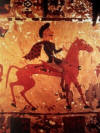| Kurgan Culture Contents | |
|
Why Pazyryk? A look at Kurgans 1. Pazyryk mtDNA Genetics - M.I.Voevoda 1998 2. Pazyryk mtDNA Genetics - I.V.Kulikov 2007 3. Y-DNA of Native Siberians - T.M.Karafet 2002 Pazyryk Craniology - Tur S.S. |
Pazyryk Timing - L.S. Marsadolov 14C Euroasian Timing 3,000 BC-50 AD - A.Yu.Alekseev et. al. Modern Türks of Pazyryk Descend - Tur S.S. |


PAZYRYK PEOPLE GENETICAL STUDY
Genetics of their moms
Khanty-Mansi, Tuvinians, and Kazakhs

Links
http://www.sati.archaeology.nsc.ru/conf/data/doc/118059942786.doc
Foreword
A good news is that there are no Iranians among the Pazyryk Scythians, unless they learned to speak Mansi and Kazakh, wear 40% East Asian genes, and don't mind looking somewhat East Asian. Read any historical or archeological description of Central Asia composed in the 20th century west of Urals, and the first page will tell you in your face that before the invasion of the Türks, that area belonged to Indo-Europeans, Indo-Iranians, Iranians, Arians and their brood. Since every child knows that the Iranians as a mass are as blond as the Swedes, the blindingly blond Iranian inhabitants of the Central Asia are assured a first runner up place in the race for a place in history, from the eternity up to the 5th c. AD. For a time, the second runner-up were the Celts, but the same scientists who once promoted them ended up soundly disqualifying them. Which left only the Iranian blonds as a viable option. The Iranian postulate did not need no scientific scrutiny, like many other widely accepted and canonized doctrines. The superb artistry and sophistication of the people could only be Iranian, or, as a bare minimum, learnt from the Iranian blonds. In other words, it is we, we, we, the glorious Indo-Europeans.
The study demonstrates that these Pazyryk Scythians had nothing to do with Iranians. They were 60/40% Caucasoids/East Asians, with protruding noses and reddish hair, basically Caucasoid features, and their own and unique Kurgan burial tradition. The raised noses, reddish hair, monkey-like appearance in the Chinese eyes, the dilution of the Siberian-Asian genes with Far Eastern genes are the facts well documented in the Chinese annals as a contribution to the Hunnic genes in the form of brides, slaves, prisoners of war, and escapees from the Chinese principalities and statelets. Other documented Far Eastern contributions are the mutual incorporations between Huns, Central Asians, Tunguses and Mongol branch, that took place in the past 2,500+ years, and associated cross-flow of genes and languages. The obvious problem with the overall approach to analysis is that Nenets/Mansi-Tuva/Kazakh samples contain different clades of the same haplogroups, and 40/60% of lemons/apples is not the same as 40/60% of oranges/pears, even though both cases reflect a 40/60% citruses/pomes. A non-discriminatory, primitive racistic approach of Russian perspective has a centuries-old crippling effect. The report's final misinterpretation of the genetical picture is a mockery of this scholarly research by the Siberian Branch of the Russian Academy of Sciences.
A separate issue is misleading timing announced in the title of the work. It is not only that the samples seem not to be individually dated, if they were, the authors were not shy to be mum on the subject. It is that the Pazyryk kurgans represent a spectrum of 1,200 years, from 13th to the 1st cc. BC, instrumentally dated (see here and here and here). We know that not only the time between the 4th-2nd cc. BC was a tumultuous time in the life around Pazyryk, but the previous centuries were not any quieter. The Ases subjugated Tochars, Usuns and Huns, all before the 4th c. BC; in around 7th c. BC the Huns approached the Chinese territories; before then came Pazyrykans and brought along their Kurgan Culture. All these events brought about genetical changes, and to interpret the analyzed 10 samples as a monolithic homogenous extraction from a homogenous and synchronous population, and expect a solid ratio across the millennia is a profanation of the study. The study is good enough to bludgeon the Scytho-Iranian Theory to its death, but it is not good enough to take a peek into the true demography of the history.